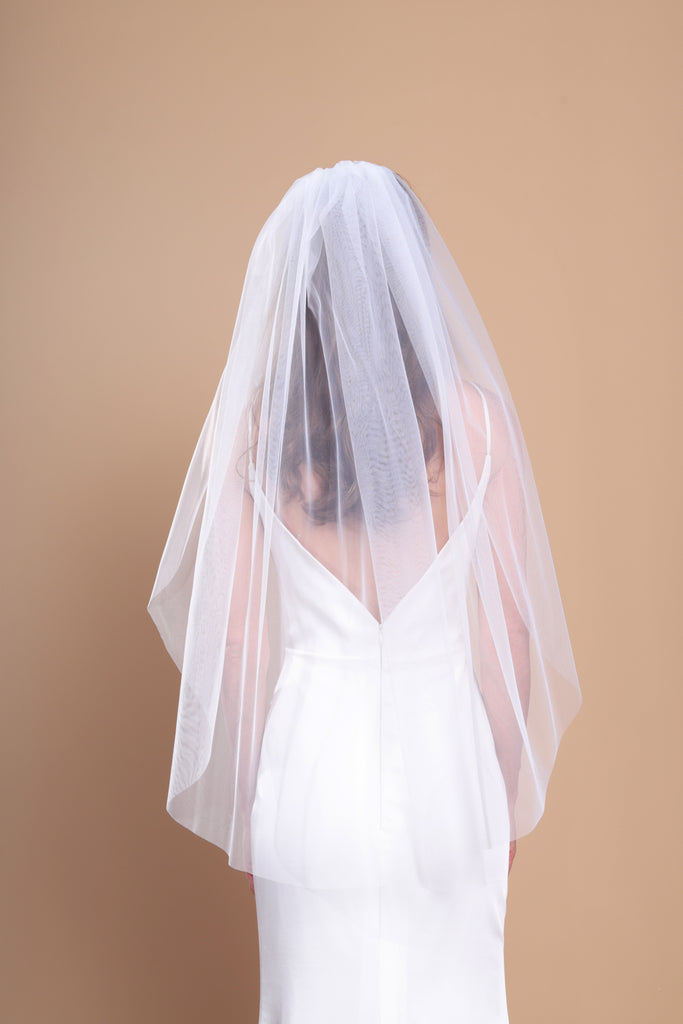Veil Gathering Styles
We have a number of veil gathering styles available here at Wendy's Boutique. This can be a difficult topic to explain but hopefully, in combination with the images below, it will start to make sense.
What Are the Most Common Gathering Styles For Veils?
In our veil collections, you’ll see the majority of our wedding veils are gathered in three main styles: centre gathered, stand gathered and ungathered. These three veil gathering styles create very different looks so let’s have a look at each of them a little more closely.
Centre Gathering
|
The centre gathered veil is the most popular of all the options by far. As its name may suggest, the veil is gathered only in the centre leaving sections of tulle on either side of the comb loose and flowing. We call these pieces “drop shoulders” and they create a very pretty effect around the bride’s arms and shoulders. If you’re looking for a veil that has a little bit of gathering, but is still quite sheer and can be brought around the arms and shoulders or worn behind, then this popular and versatile gathering style is the one for you. Let’s try and give you a sense of what this gathering style looks like now with a selection of veils in this style. |
|
 |
 |
 |
| Centre gathering from the front worn over the face | Centre gathered veil from the side | Centre gathered veil from the back |
Mantilla Style
 |
 |
 |
| Front view of mantilla style |
Side view of mantilla style | Example of a mantilla veil |
Drop Veils
|
The drop veil is a pretty, sheer style that actually has zero gathering at the comb. A few folds will appear in the veil naturally as it’s shaped over the head. But there are no sewn gathered lines at the comb area making this type of veil the sheerest and most delicate of them all. Our Charlotte doesn't have any comb or hairpin attached, so you need to use a hairpin that you received from us or any haipin you like to fix it to hair when you wear it. The drop veil style is better suited to plain veils. Keeping the veil as light as possible puts less pressure on the ungathered tulle at the comb area. |
 |
 |
 |
 |
| Example of a drop veil | Drop veil from the side worn over the face | Drop veil from the back worn over the face |
As you can see, the drop veil is stunning and so beautifully sheer. Hopefully the benefits of this style are pretty self-explanatory!
“Barely-there”
|
There is no gathering at the comb of a “barely there” veil making it ultra-sheer and minimal in style. With no vertical gathering lines in the tulle, you can really see every detail of your dress so they’re great for open or backless dresses or ornate lace illusion backs. They usually come with light or ultral light veils. Gathering equals strength, so if you want lace on your veil I would recommend the traditional gathered veil or a mantilla style which can both take the weight of the lace where the barely-there veils can’t. That said, barely-there veils are perfect for plain veils. |
 |
 |
 |
 |
| Front view of 'Barely-there' | Back view of 'Barely-there' | Side view of 'Barely-there' |
Stand Gathering
| This is the traditional and most commonly seen gathering style on a single layer veil, with its pleated gathering at the comb. If worn at the back of the head it will sit in a slim column down the bride’s back, or if worn slightly higher up it can frame the bride’s arms and shoulders too. When in doubt, this is the one to go for. |  |
 |
 |
 |
| Back view of a standard gathered single layer veil | Side view of a standard gathered one layer veil | Front view of a standard gathered single layer veil |
Still Unsure?
More Veil Guides


